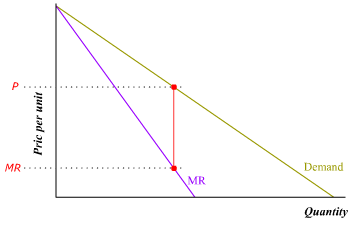Single-pricing means charging the same price to all buyers regardless of their reservation prices1 in one pricing period. Those buyers whose reservation prices are higher than the single price will gain consumer surplus. Those whose reservation prices are lower than the single price will have to do without. Single-pricing is practiced when sellers do not have enough pricing power to charge a different price to each buyer according to his reservation price. Thus, all sellers who are not practicing perfect price discrimination are single-pricers to various degrees. However, price takers individually have no power to change the single price. Only price searchers can adjust their single prices to take advantage of varying demand elasticities over prices.
Price searchers
Price searchers have some power to set their prices because they are selling differentiated products. They are facing a typically downward-sloping demand curve. To price searchers, single-pricing means that the price for all units must be lowered just to sell one more unit. As a result, the additional revenue (MR) generated by selling one more unit will be lower than the price (P) itself. See following diagram.

A numerical example:

MR ($3.99) < Price ($4.99).
In other words, the marginal benefit (MB = P) of selling one more unit to the buyer always exceeds the marginal revenue (MR) to price-searching sellers under single-pricing
Thus, when the price searcher maximizes his profit at MR = MC, P (i.e., MB) > MC. Since maximum efficiency (i.e., the largest amount of economic surplus2) requires P = MC, price searchers would always be producing less than the maximum-efficiency output (see Pricing and Economic Surplus).
Price takers
Price takers accept whatever the market price happens to be. They have no market power to charge a different price because its many free-entry competitors are selling identical products. They face a typically horizontal demand curve. See following diagram.

This powerlessness means that selling one more unit would bring in marginal revenue exactly equal to the market price. In other words, MR = P.
Thus, when the price taker maximizes his profit at MR = MC, P (i.e., MB) = MC; which happens to be the condition for maximum efficiency.
- The highest price a buyer is willing to pay rather than doing without.
- Economic surplus is the difference between the reservation price (highest price one is willing to pay) and the marginal cost of a good. Total economic surplus is the sum of total consumer surplus and total economic profit.
